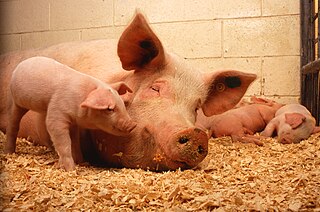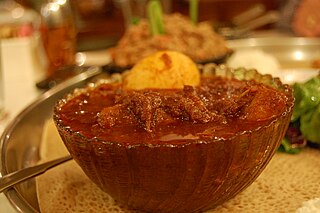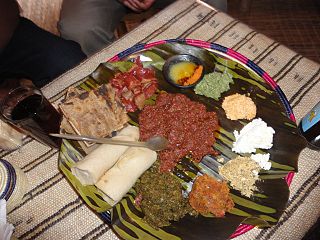Ethiopian Jewish cuisine is the cuisine of the Beta Israel (Ethiopian Jews). The cuisine of the Ethiopian Jews is similar to the cuisine of other Ethiopians, with some variations.
Because treyf foods such as pork and shellfish are not traditionally eaten by either Ethiopian Christians or Ethiopian Muslims, keeping kosher in Ethiopia is a largely invisible practice. However, there are some noticeable distinctions. Ethiopian Jews refrain from eating popular national dishes made from raw meat, such as kitfo and gored gored . [1]
Ethiopian-Jewish dietary laws are based mainly on Leviticus, Deuteronomy and Jubilees.
Permitted and forbidden animals and their signs appear on Leviticus 11:3–8 and Deuteronomy 14:4–8. Forbidden birds are listed on Leviticus 11:13–23 and Deuteronomy 14:12–20. Signs of permitted fish are written on Leviticus 11:9–12 and Deuteronomy 14:9–10. Insects and larvae are forbidden according to Leviticus 11:41–42. Birds of prey are forbidden according to Leviticus 11:13–19.
Gid hanasheh is forbidden per Genesis 32:33. Mixtures of milk and meat are not prepared or eaten but are not banned either: Haymanot interpreted the verses Exodus 23:19, Exodus 34:26 and Deuteronomy 14:21 literally "shalt not seethe a kid in its mother's milk" (like the Karaites). Currently, under Rabbinic influence, mixing dairy products with meat is prohibited.
Ethiopian Jews were forbidden to eat the food of non-Jews. A kes only eats meat he has slaughtered himself, which his hosts then prepare both for him and themselves.
Beta Israel who broke these taboos were ostracized and had to undergo a purification process. Purification included fasting for one or more days, eating only uncooked chickpeas provided by the kes, and ritual purification before entering the village. Unlike other Ethiopians, the Beta Israel do not eat raw meat dishes such as kitfo or gored gored. [2]
Ghee and niter kibbeh (types of clarified butter) are popular components of Ethiopian cuisine, including Ethiopian-Jewish cuisine. To avoid mixtures of meat and dairy, oil can be used as a parev substitute for clarified butter. [3] Kosher ghee, certified by the Orthodox Union, is available for US markets.
Because excess moisture is removed from ghee through heat treatment, the heating equipment must be verified as kosher as well, which adds an extra step to the kashering process. [4] Ghee is commonly used in Middle Eastern cuisine and thus kosher ghee is widely available in Israel. Yeqimem zeyet is a form of niter kibbeh made from vegetable oil and is useful as a parev and vegan alternative to dairy-based niter kibbeh. [5]
Camel meat is traditionally eaten by Ethiopian Muslims, but it is not eaten by either Ethiopian Jews or Ethiopian Christians. Camels are not a kosher animal. Camel milk is commonly consumed in Ethiopia, but is not consumed by Ethiopian Jews because it is not kosher (kosher milk must come from kosher animals).
Shabbat is known as Sanbat in the Amharic and Tigrinya languages.
Sanbat Wat (Sabbath Wat) is a traditional Ethiopian-Jewish wat that is prepared for Shabbat. Sanbat Wat is a doro wat of chicken and hard-boiled eggs served with injera. Sanbat Wat is a spicy dish and is commonly seasoned with berbere, cloves, onions, tomato sauce, and other savory ingredients. [6] Wats made from chicken, meat, and fish are most commonly eaten for Shabbat dinner while vegetarian wats are eaten for breakfast.
Dabos, small round rolls, are traditionally served during Shabbat meals. Because Ethiopian Jews usually lacked wine for kiddush , tallah (a beer fermented from gesho leaves) was often used as a substitute. Due to the availability of wine in Israel, Ethiopian-Israelis generally use wine for kiddush. [7]
Because Ethiopian Jews traditionally interpret halakhic prohibitions against cooking on Shabbat literally, no heating of food is done on Shabbat. All foods are prepared on Erev Shabbat (Friday) and served room temperature. [7]
Ethiopian Jews who are Shomer Shabbat cannot perform buna, [8] the traditional Ethiopian coffee ceremony, during Shabbat. Buna requires lighting a fire and thus the ceremony must be performed before or after Shabbat.
Ethiopian matzah is baked as a circular flatbread 2 feet in diameter, with a soft texture like pita. [9]
While most Jews stopped the practice of the Passover sacrifice after the destruction of the Second Temple, some Ethiopian Jews still continue the practice.
Rosh Hashanah is known as Brenha Serkan in Amharic, meaning "the rising of the dawn." Ethiopian Jews traditionally only observed Rosh Hashanah for one day, as opposed to the two days usually observed by Jews elsewhere in the diaspora and in Israel.
Lamb, the most expensive meat available in Ethiopia, was served for the holiday. It was customary for affluent members of the community to hold a community feast for the holiday and invite other members of the community to join. [10]
Ethiopian Jews fast for the holiday of Sigd . To break the fast, it is traditional to eat a lamb or chicken stew served with eggs and potatoes.
Since meat can be scarce in Ethiopia, Ethiopian Jews usually only eat meat-based stews once a week for Shabbat, and for holidays. [11]
There are few kosher Ethiopian-Jewish restaurants worldwide, even in Israel. However, more kosher Ethiopian restaurants have opened in Israel over time. Several kosher Ethiopian restaurants have opened in Jerusalem and Tel Aviv. A kosher vegan Ethiopian restaurant exists in Tel Aviv. [12]
In Harlem, the Tsion Cafe serves non-kosher Ethiopian-Jewish/Ethiopian-Israeli inspired cuisine. [13] A kosher vegan Ethiopian restaurant was opened in Brooklyn in March 2020, certified with the "Mason Jar K" hechsher under the superversion of Rabbi Sam Reinstein of Congregation Kol Israel. [14] [15]
As of 2019, there are no kosher restaurants in Addis Ababa. However, the Chabad house in Addis Ababa offers kosher food. [16]

Ethiopian cuisine characteristically consists of vegetable and often very spicy meat dishes. This is usually in the form of wat, a thick stew, served on top of injera, a large sourdough flatbread, which is about 50 centimeters in diameter and made out of fermented teff flour. Ethiopians eat most of the time with their right hands, using pieces of injera to pick up bites of entrées and side dishes.
Kashrut is a set of dietary laws dealing with the foods that Jews are permitted to eat and how those foods must be prepared according to Jewish law. Food that may be consumed is deemed kosher, from the Ashkenazic pronunciation (KUHsher) of Hebrew kashér, meaning "fit".

In some religions, an unclean animal is an animal whose consumption or handling is taboo. According to these religions, persons who handle such animals may need to ritually purify themselves to get rid of their uncleanliness.

Kosher foods are those that conform to the Jewish dietary regulations of kashrut, primarily derived from Leviticus 11 and Deuteronomy 14:1-21. Food that may be consumed according to halakha (law) is termed kosher in English, from the Ashkenazi pronunciation of the Hebrew term kashér, meaning "fit". Food that is not in accordance with law is called treif meaning "torn."

Jewish cuisine refers to the worldwide cooking traditions of the Jewish people. During its evolution over the course of many centuries, it has been shaped by Jewish dietary laws (kashrut), Jewish festivals and holidays, and traditions centred around Shabbat. Jewish cuisine is influenced by the economics, agriculture, and culinary traditions of the many countries where Jewish communities have settled and varies widely throughout the entire world.

Cholent or Hamin is a traditional Jewish stew. It is usually simmered overnight for 12 hours or more, and eaten for lunch on Shabbat. Cholent was developed over the centuries to conform with Jewish laws that prohibit cooking on the Sabbath. The pot is brought to a boil on Friday before the Sabbath begins, and kept on a blech or hotplate, or left in a slow oven or electric slow cooker, until the following day. Cholent originated in ancient Judea, possibly as far back as the Second Temple period, and over the centuries various Jewish diaspora communities created their own variations of the dish.

Wat or Wot or Tsebhi is an Ethiopian and Eritrean stew that may be prepared with chicken, beef, lamb, a variety of vegetables, spice mixtures such as berbere, and niter kibbeh, a seasoned clarified butter.

Niter kibbeh, or niter qibe, also called tesmi, is a seasoned, clarified butter used in Ethiopian and Eritrean cuisine. Its preparation is similar to that of ghee, but niter kibbeh is simmered with spices such as besobela, koseret, fenugreek, cumin, coriander, turmeric, Ethiopian cardamom (korarima), cinnamon, or nutmeg before straining, imparting a distinct, spicy aroma. The version using vegetable oil instead of butter is called yeqimem zeyet.
Some people do not eat various specific foods and beverages in conformity with various religious, cultural, legal or other societal prohibitions. Many of these prohibitions constitute taboos. Many food taboos and other prohibitions forbid the meat of a particular animal, including mammals, rodents, reptiles, amphibians, fish, molluscs, crustaceans and insects, which may relate to a disgust response being more often associated with meats than plant-based foods. Some prohibitions are specific to a particular part or excretion of an animal, while others forgo the consumption of plants or fungi.

Shiro, also called Shiro Wat, or Tsebhi Shiro, is an East African stew. Its primary ingredient is powdered chickpeas or broad bean meal and often prepared with the addition of minced onions, garlic and, depending upon regional variation, ground ginger or chopped tomatoes and chili-peppers. Shiro is served atop injera or kitcha. Tegabino shiro is a type of shiro made from heavily spiced legume, chickpea, field pea, or fava bean, oil, and water. It is brought bubbling to the table in a miniature clay pot or shallow aluminum pan. It is often consumed with dark or sergegna injera.

Sephardic Jewish cuisine is an assortment of cooking traditions that developed among the Sephardi Jews.

Kosher animals are animals that comply with the regulations of kashrut and are considered kosher foods. These dietary laws ultimately derive from various passages in the Torah with various modifications, additions and clarifications added to these rules by halakha. Various other animal-related rules are contained in the 613 commandments.

Israeli cuisine comprises both local dishes and dishes brought to Israel by Jews from the Diaspora. Since before the establishment of the State of Israel in 1948, and particularly since the late 1970s, an Israeli Jewish fusion cuisine has developed.
Mixtures of milk and meat are forbidden according to Jewish law. This dietary law, basic to kashrut, is based on two verses in the Book of Exodus, which forbid "boiling a (goat) kid in its mother's milk" and a third repetition of this prohibition in Deuteronomy.

Mizrahi Jewish cuisine is an assortment of cooking traditions that developed among the Jews of the Middle East, North Africa, Asia, and Arab countries. Mizrahi Jews have also been known as Oriental Jews.
Haymanot is the branch of Judaism which is practiced by the Beta Israel, also known as Ethiopian Jews.

Djiboutian cuisine is a mixture of Somali, Afar, Yemeni, and French cuisine, with some additional South Asian culinary influences.

Brisket is a popular Jewish dish of braised beef brisket, served hot and traditionally accompanied by potato kugel, latkes, and/or matzo ball soup. It is of Ashkenazi Jewish origin and is commonly served for Jewish holidays such as Hanukkah, Passover, Rosh Hashanah, and Shabbat. It is commonly found in Jewish communities worldwide, though it is most commonly associated with Jews in the United States, where it has been considered the most important and iconic Jewish main course since the early 20th century.
Ashkenazi Jewish cuisine is an assortment of cooking traditions that developed among the Jews of Eastern, Central, Western, Northern, and Southern Europe, and their diaspora mainly concentrated in North America and other Western countries.